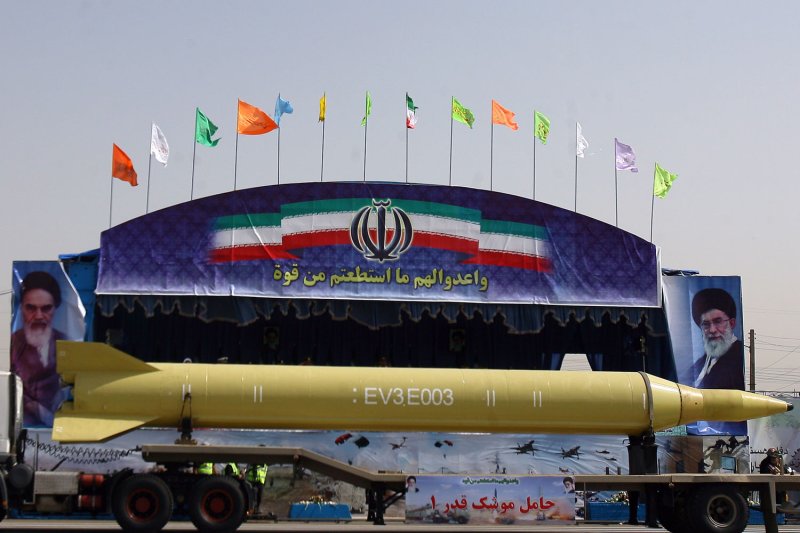Iran's Qadr 1 missile is displayed during a military parade to mark the beginning of the 1980-1988 war between Iran and Iraq on September 22,2009 in Tehran, Iran. UPI/Maryam Rahmanian |
License Photo
TEHRAN, Jan. 2 (UPI) -- Iran successfully test-fired long-range missiles in the Persian Gulf Monday, a day after testing a medium-range missile, an Iranian military official said.
"We have test fired a long-range shore-to-sea missile called Qader [capable], which managed to successfully destroy predetermined targets in the gulf," Rear Adm. Mahmoud Mousavi told the official Islamic Republic News Agency.
The test-firing of the anti-ship cruise missiles, based on Chinese C-802 radar-evading missiles, would take place on the last of 10 days of Iranian war games in the Strait of Hormuz, a strategic, narrow shipping lane through which 40 percent of world oil flows.
Iranian officials threatened last week to close the strait, halting all oil shipments, if the West imposed sanctions on Iranian oil exports.
The U.S. Fifth Fleet, based in Manama, Bahrain, about 100 miles from Iran's coastline, responded by saying it would not tolerate "any disruption."
Iran backed off from the shutdown threat Sunday, with Mousavi telling the semi-official Iranian Students News Agency Iran would not "disrupt traffic" through the strait.
"We are not after this," he said.
Separately, the Iranian Atomic Energy Organization said Sunday Iran successfully produced and tested fuel rods for use in its nuclear power plants.
The rods, made with uranium mined in Iran, were inserted into the core of Tehran's research nuclear reactor, the agency told Iranian state TV.
Iran said last month it planned to insert domestically produced uranium fuel into the reactor, which produces isotopes Iran claims are for medical purposes.
U.S. and European officials, supported by the International Atomic Energy Agency, allege Tehran is planning to build nuclear weapons.
The Tehran reactor runs on a nearly depleted stock of nuclear plates bought from Argentina in 1993, al-Jazeera reported.
The nuclear-plant and test-firing moves came after U.S. President Barack Obama signed a law Saturday imposing tougher financial sanctions to punish Iran for its nuclear research program.
The legislation penalizes foreign corporations that do business with Iran's central bank, which collects payments for most of the country's energy exports.
Iran, the world's No. 3 energy exporter, relies on oil exports to finance as much as half its national budget.
The sanctions are intended to make it difficult for those who do business with the central bank to also do business with the United States, The New York Times said. The bill includes loopholes to reduce the penalties on close allies that support pressuring Iran to abandon its nuclear program.
Iranian officials insist their nuclear goal is to generate electricity without dipping into the oil supply they prefer to sell abroad, and to provide fuel for medical reactors.
The IAEA published a report last month that for the first time laid out evidence Iran may be secretly working to design a nuclear warhead.
The European Union says it will consider imposing its own strict new sanctions against Iran, including an embargo on Iranian oil, next month.
EU countries receive 450,000 barrels a day of Iranian oil.















